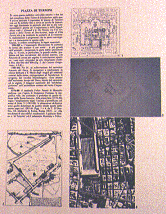Piazza di Termini: Recent History
 |

|
 |
Piazza di Termini: A Timeline of Urban Development
Until a century ago, the vast public space in Rome that was enclosed on two sides by the ancient Baths (Terme) of Diocletian was known as the "Piazza di Termini," a toponym derived from the massive Roman ruins. Today, this single appellation has been replaced by a series of commemorative place names: Piazza dei Cinquecento, Piazza della Repubblica, Viale L. Einaudi, Viale E. De Nicola, Via V. E. Orlando, Via delle Terme di Diocleziano, Largo di Villa Peretti, etc. Together, all these names record the long history of events, architectural programs, and development projects that successively converged upon and transformed this area of Rome.
298-305:
The emperor Diocletian constructed the monumental bath complex that bears his name-the largest in antiquity-in part over earlier structures (fig. 1). Particularly striking was the great semicircular exedra on the west side of the enclosure wall. This hemicycle served as a place for recreational sport and exercise. Its remains, surrounded by gardens, were still visible until the end of the 19th century (fig. 2: from the Castato Gregoriano, A.S.R.).
1561-66:
Pope Pius IV, at the behest of Father Antonio del Duca, restored the central section of the Baths, the ancient tepidarium, and transformed it into the Church of S. Maria degli Angeli. The project, originally conceived by Michelangelo, was carried out with the assistance of Jacopp del Duca, nephew of the priest, and therefore became the foremost example of "Michelangelism" in Roman architecture of the late 16th century.
1576-88:
The Cardinal Felice Peretti di Montalto erected, with the architect Domenico Fontana, the magnificent villa that became the prototype for the famous villas of Baroque Rome. The first phase (1576-80) was enlarged after the accession of Pope Sisto V (1585-88); its final dimensions were delimited by the four streets that were opened by this pope in 1585-86 (figs. 3 and 4: form C. D'Onofrio, Gli obelischi di Roma, Rome 1967). The villa contained two residential buildings: the Palazzo Sistino or "di Termini" and the Palazzetto Montalto e Felice.



